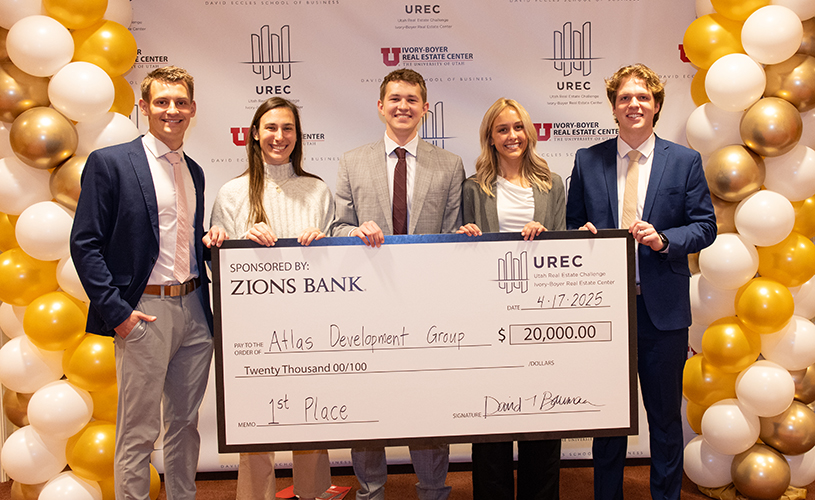at the University of Utah
Utah Real Estate Challenge awards $20K prize to first-place team
Three teams made one last presentation on April 17 in a bid for a $20,000 first prize in the final round of the annual Utah Real Estate Challenge (UREC) — an intercollegiate competition supported by the Ivory-Boyer Real Estate Center (IBREC) and the David Eccles School of Business’s Master of Real Estate Development program.
Some 15 teams comprised of 63 students (from the University of Utah, BYU, Utah State and Utah Valley) initially entered the competition, which challenged them to select and evaluate a property of their choice within Salt Lake City’s central business district — located between 200 East to I-15 and 200 North to 800 South — and to prepare development business proposals and present to a panel of real estate expert judges.
After an initial round of judging took place March 5, the three teams with the highest scores were invited to the UREC luncheon at the Little America Hotel, where they gave another presentation, this time in a ballroom packed with industry professionals. The teams’ initial scores, an evaluation of their final presentation, and an audience vote all factored into determining the final result.
“I can’t overstate how much effort it takes to put these presentations together,” said David Bauman, executive director of IBREC. “This competition is demanding, and these students put in hours and hours and hours of their lives.”
The $20,000 first prize went to the Atlas Development Group and its “WestEnd” project — a public-private mixed-use development that would include 337 residential units (with 15% master-leased for West High School faculty, staff, and student families), plus ground-level retail space (including a café, coffee shop, and dog day-care), as well as a parking garage. The ground lease would give the Salt Lake Board of Education an estimated $630,000 annually, while the garage would generate about $300,000 annually for the school. Team members included Calli Glazier, Dawson Kearns, Brandon Reese, Raef Thomas, and Jessica Zuban.
Second place and a $10,000 prize went to UPLIFT Real Estate Group and its “Triple 7 State” project, a mixed-used development featuring 188 mixed-income affordable housing units, medical outpatient centers, retail, daycare, and a career center. Located across from the proposed Intermountain Urban Hospital, Triple 7 State would be within a Qualified Census Tract, SLC RDA project area, and HTRZ eligible area, making it able to leverage a unique blend of public-private partnerships and funding sources. Team members included Taylor Alvarez, Sean Donner, Sam Hosac, and Will McCoy.
Taking third place and earning a $5,000 prize was The ACOTA Group, whose “HIVE” project featured two buildings — one a 55-plus active adult community building, the other a multifamily apartment building with a variety of unit sizes — connected by lobby, amenity, and retail space (including a neighborhood grocery market) as well as park space to connect the separate buildings. Team members included Avery Albright, Olivia Gillette, Tyler Hopkin, Austin Keller, and Christopher Wilson.
The event also featured a keynote address from Salt Lake City Mayor Erin Mendenhall, who spoke to the complexity of the challenge the competitors were given.
“This is not your average development site — this is where the civic identity, infrastructure complexity, cultural legacy, and economically momentum all converge, and where also the width of our streets has been pre-determined based upon how much room an ox cart needs to flip a U-turn,” Mendenhall said to laughs.
“This year’s challenge zone is home to the most urban stretch of Main Street; iconic Temple Square; integrated shopping malls like The Gateway and City Creek Center; the Delta Center, home to the Utah Jazz and our brand-new Utah Hockey Club; the state’s busiest transit corridor; and a dense concentration of restaurants, breweries, shops, housing, and civic institutions like the opera, symphony and ballet — just to name a few,” she added. “You had to plan a development in a place where hundreds of thousands of people already live, work, gather, and commute with so many thousands more in the works. Two hundred thousand residents here — to be specific — in the city, and doubling that number during the workday, on many evenings, and throughout the weekends. That’s no small feat for development envisioning.”
The UREC competition is made possible by the generous support of the Ivory-Boyer Real Estate Center Board, sponsors, mentors, judges, and faculty from participating schools.





